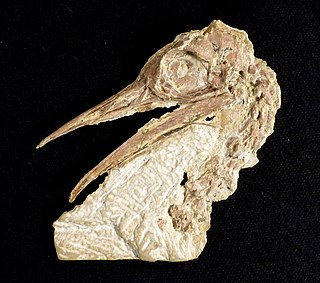 W
WPalaeognathae is a clade of birds, called paleognaths, within the subclass Neornithes of the class Aves. It is one of the two extant infraclasses of birds, the other being Neognathae, both of which form Neornithes. Palaeognathae contains five extant branches of flightless lineages, termed ratites, and one flying lineage, the Neotropic tinamous. There are forty-seven species of tinamous, five of kiwis (Apteryx), three of cassowaries (Casuarius), one of emus (Dromaius), two of rheas (Rhea) and two of ostrich (Struthio). Recent research has indicated that paleognaths are monophyletic but the traditional taxonomic split between flightless and flighted forms is incorrect; tinamous are within the ratite radiation, meaning flightlessness arose independently multiple times via parallel evolution.
 W
WLithornis is a genus of extinct paleognathous birds. Lithornis were able to fly well, but are closely related to today's tinamous and ratites.
 W
WLithornithidae is an extinct, possibly paraphyletic group of early paleognath birds. They are known from fossils dating to the Upper Paleocene through the Middle Eocene of North America and Europe, with possible Late Cretaceous representatives. All are extinct today; the youngest specimen is the currently unnamed SGPIMH MEV1 specimen from the mid-Eocene Messel Pit site.
 W
WNothurinae or aridland tinamous is one of two subfamilies of the Tinamidae family, the other being Tinaminae. It contains eighteen species in six genera. The six genera are:Rhynchotus Nothoprocta Nothura Taoniscus (monotypic) - dwarf tinamou Eudromia Tinamotis
 W
WNotopalaeognathae is a clade that contains the order Rheiformes (rheas), the clade Novaeratitae, the order Tinamiformes (tinamous) and the extinct order Dinornithiformes. The exact relationships of this group have only recently been understood, with tinamous and the moas sharing a common ancestor and the kiwis being more closely related to emus and cassowaries. The extinct elephant birds of Madagascar have recently been identified as closest relative to the kiwis. The rheas are either the basal most branch of notopalaeognaths or the sister group to Novaeratitae. The sister group to Notopalaeognathae is Struthionidae.
 W
WNovaeratitae is a clade that was originally defined to contain the recent common ancestors of the orders Casuariiformes and Apterygiformes (kiwis). Recently it has been determined that the elephant birds of the extinct order Aepyornithiformes were the closest relatives of the kiwis, and therefore are part of this group. The implication is that ratites had lost flight independently in each group, as the elephant birds are the only novaeratites found outside Oceania.
 W
WPseudocrypturus is a genus of extinct paleognathous bird. One species is known, Pseudocrypturus cercanaxius. It is a relative of such modern birds as ostriches. It lived in the early Eocene. The holotype fossil is in the collection of the Smithsonian's National Museum of Natural History. It has catalog number USNM 336103. It was collected from the Fossil Butte Member, Green River Formation, Lincoln County, Wyoming, USA.
 W
WTinaminae, the forest tinamous, is one of two subfamilies of the family Tinamidae, the other being Nothurinae. Tinaminae has more species than the other subfamily, containing 29 species in three genera:Crypturellus Nothocercus Tinamus